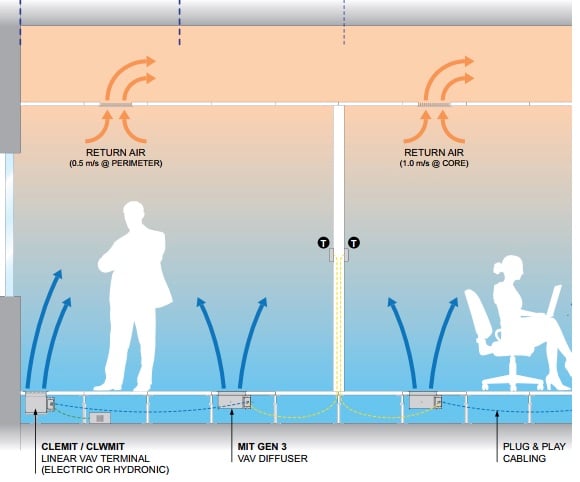Advantages of Raised Access Floors: 4 Signs That You're Missing the Mark
In the twenty or thirty years since architects began incorporating raised access flooring (RAF) into their building designs, occupants of these...
Floor, wall and ceiling mounted to meet your unique project design.


People in the United States spend a lot of time indoors. Between their homes, vehicles, and workplaces, it’s estimated that the average person spends 90% of their time inside.
Understandably, with all that time spent indoors, people aren’t getting the fresh air they need.
Modern buildings are designed to prevent air from entering or escaping the building. This lack of ventilation has been found to cause health problems for those inside.
This is called sick building syndrome (SBS), and it’s a common issue for many buildings throughout the U.S.
What is the definition of sick building syndrome? According to the Environmental Protection Agency (EPA), sick building syndrome is a situation in which building occupants experience health issues and discomfort linked to their time spent in a building, without being able to identify specific underlying medical conditions.
The primary risk factor for sick building syndrome is poor air ventilation, and it’s usually caused by a building’s HVAC system. Without proper ventilation, all the air inside the building is constantly recirculated by the HVAC system.
Any pollutants, irritants, odors, and chemicals in the air continuously flow throughout the building until the levels get high enough to make people sick.
While the health effects of sick building syndrome are generally mild, they can lead to other issues such as fatigue, lack of motivation, and difficulty to focus, which can severely affect business efficiency.
Sick building syndrome is a relatively modern problem that began in the 1970s during the energy crisis. The focus was to build buildings as airtight as possible - but before then, ventilation standards required buildings to have at least 15 cubic feet per minute of fresh air vented into the building per person.
That all changed when the U.S. went through an oil embargo in the early 1970s. Energy prices skyrocketed, and national conservation measures reduced the amount of fresh air required in commercial buildings to a mere five cubic feet per minute.
While this change did make buildings more energy-efficient, it also limited the amount of fresh air able to enter a building, creating something else: the sick building syndrome.
By 1984, the World Health Organization (WHO) estimated that over 30% of new and remodeled buildings worldwide were affected by sick building syndrome, and the numbers kept climbing from there.
Sick building syndrome is caused by a lack of fresh air in a building. Many HVAC systems don’t allow an adequate supply of outside air to enter the building, leading to health problems for those inside.
While poor air ventilation is the main cause of sick building syndrome, it’s the circulated contaminants that affect health. These contaminants include anything that could affect indoor air quality:
The longer your HVAC circulates these contaminants throughout the building, the worse the indoor air quality becomes.
Indoor air quality has a major effect on health and productivity. When employees don’t feel good, they become easily distracted and lose motivation. In addition to hindering your employees, poor air quality can also affect clients who visit your office, resulting in a more unpleasant experience and pushing them to an overall negative perception.
The symptoms of sick building syndrome are generally mild but enough to cause discomfort and irritability for those exposed, including:
If sick building syndrome isn’t addressed, prolonged exposure to poor indoor air quality could lead to a more serious condition called building related illness (BRI). BRI symptoms include coughing, fever, chills, and chest tightness. While SBS symptoms typically disappear once you leave the building, BRI is more long term and might take weeks or months to recover.
It’s important to quickly address indoor air quality issues to limit their effect on those working in your building.
It shouldn’t come as a surprise: When employees don’t feel well, they don’t work as hard. Sick building syndrome statistics show that better air quality can boost employee productivity by almost 10%. So, if you think you might be working in a sick building, here are some tips to boost your indoor air quality.
Scour your workspace for anything that could release pollutants into the air. These could include water-damaged ceiling tiles, dirty carpets, overfilled or uncovered trash bins, and even smoking areas too close to the building.
If you remove the source of the contaminants, there will be less to circulate around the office.
The main sick building syndrome cause is the lack of outdoor ventilation, so the more air you let into the building, the better the air quality will become. Open when possible and make sure your HVAC system is well maintained.
In many cases, it may be more cost-effective to simply upgrade your HVAC system to a modern system that can benefit air quality, like an underfloor air distribution system.
Underfloor Air Distribution (UFAD) is an alternative to traditional HVAC setups. Instead of using large ducts responsible for carrying the air both into and out of the space (which contaminate the fresh air), a UFAD system releases conditioned air at the floor and vents the older warm air at the ceiling.
Since the conditioned air and the old air never meet, UFAD systems offer much better indoor air quality than traditional HVAC systems. Plus, since they work with the laws of physics (warm air rises), they’re 30% more energy efficient as well.
If you’re interested in creating a healthier, more productive work environment, an underfloor air distribution system might be for you. At AirFixture, we have decades of experience helping businesses all over the world increase their indoor air quality and reduce energy costs. Contact us today to learn more about how UFAD can cure your sick building syndrome, and make your building a happier and healthier environment for everyone.
In the twenty or thirty years since architects began incorporating raised access flooring (RAF) into their building designs, occupants of these...

Architects and building designers face difficult decisions when developing a design for a new or retrofitted building. From ceiling heights to...

The county of San Francisco is a hotspot for property developers. As tech companies spilled over from Silicon Valley, office and rental prices shot...